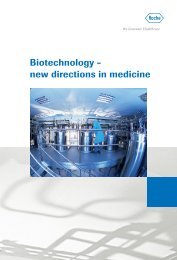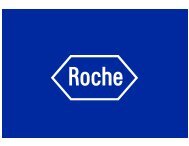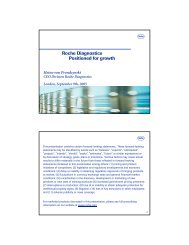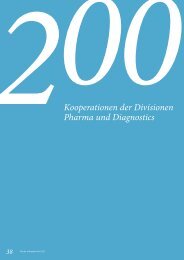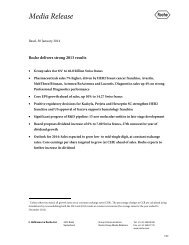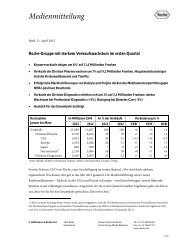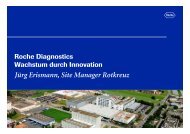Safety, health and environmental protection - Roche
Safety, health and environmental protection - Roche
Safety, health and environmental protection - Roche
Create successful ePaper yourself
Turn your PDF publications into a flip-book with our unique Google optimized e-Paper software.
<strong>Safety</strong>, <strong>health</strong> <strong>and</strong><br />
<strong>environmental</strong> <strong>protection</strong><br />
In brief<br />
• Won the Financial Times/Citi Private Bank Environmental<br />
Award for the Greatest Improvement<br />
in Carbon Efficiency by a Large Enterprise<br />
• Energy use per employee increased slightly by<br />
1.1%<br />
• Environmental footprint reduced by 5%<br />
• Volatile organic compound emissions reduced<br />
by 15%<br />
Respect for the environment is an important<br />
part of our wider commitment to safety, <strong>health</strong><br />
<strong>and</strong> <strong>environmental</strong> <strong>protection</strong> (SHE) in all our<br />
activities. This commitment is embodied in our<br />
Corporate Principles <strong>and</strong> SHE Policy (see<br />
www.roche.com/sus-she).<br />
In 2007 we invested 215 million Swiss francs in<br />
SHE infrastructure <strong>and</strong> 306 million Swiss francs<br />
in SHE operating costs, including services <strong>and</strong> personnel.<br />
Pharmaceuticals can enter the environment in a<br />
variety of ways: through the manufacturing process,<br />
improper disposal of unused medicines, <strong>and</strong><br />
through patients who take medicines that eventually<br />
pass through the human body. We have developed<br />
a global position on pharmaceuticals in the<br />
environment, which we will publish in 2008. Our<br />
medicines show negligible effects on the endocrine<br />
system when released to the environment, although<br />
this is an increasing concern. Here we discuss the<br />
direct SHE impacts of our operations.<br />
SHE management<br />
In 2007 we updated our SHE guidelines. We made<br />
them more precise so they are easier to underst<strong>and</strong><br />
<strong>and</strong> added new instructions on how the guidelines<br />
should be applied in daily business. The new guidelines<br />
are available on our internal <strong>and</strong> external websites.<br />
We ask all our employees to follow the guidelines<br />
<strong>and</strong> make SHE a normal part of our business.<br />
Some 630 employees work full-time in SHE<br />
across the <strong>Roche</strong> Group, including a team of<br />
16 people at our headquarters in Basel. The site<br />
manager <strong>and</strong> safety, <strong>health</strong> <strong>and</strong> <strong>environmental</strong><br />
officer (SEO) at each of our facilities ensure the<br />
SHE policy <strong>and</strong> guidelines are implemented<br />
locally. Individual employees from each division<br />
take on the role of ‘eco-delegate’ in addition to their<br />
regular jobs to help to raise awareness about SHE<br />
issues.<br />
We audit sites across the Group to make sure that<br />
our SHE policy <strong>and</strong> guidelines are implemented<br />
correctly. In 2007 we audited 27 sites. SHE performance<br />
was generally good at these sites <strong>and</strong><br />
no major non-compliance issues were raised. Recommendations<br />
have been made to improve SHE<br />
risk management at these sites <strong>and</strong> their implementation<br />
is being supervised by the audit team.<br />
We regularly bring together our SEOs from around<br />
the world to train them <strong>and</strong> raise awareness of our<br />
SHE goals. The SEOs take this knowledge back to<br />
their sites <strong>and</strong> use it when training local employees.<br />
Site-based training includes lectures <strong>and</strong> practical,<br />
h<strong>and</strong>s-on courses. Employees who are keen to know<br />
more can take part in further education programmes<br />
about SHE. We provided 125,000 hours<br />
of SHE training to 51,500 employees in 2007.<br />
We also train employees to use chemicals safely,<br />
<strong>and</strong> produce information sheets on how to h<strong>and</strong>le<br />
particularly hazardous chemicals, to prevent harm<br />
to our employees, customers or the environment.<br />
Over the past decade we have produced more than<br />
1,000 of these information sheets, <strong>and</strong> published<br />
those for commercialised substances internally <strong>and</strong><br />
on our website.<br />
We work hard to reduce SHE risks <strong>and</strong> prevent incidents.<br />
We have set up a web-based tool to help site<br />
managers to log <strong>and</strong> assess risks at their facilities.<br />
Our corporate SHE team evaluates this information<br />
to build a global risk profile <strong>and</strong> monitors risk<br />
assessments by site managers.<br />
80 Business Report 2007
<strong>Safety</strong>, <strong>health</strong> <strong>and</strong> <strong>environmental</strong> <strong>protection</strong><br />
We set a number of global long-term SHE goals<br />
in 2005. Individual sites have since adopted local<br />
goals <strong>and</strong> developed action plans to help us meet<br />
the Group targets. These plans were reviewed <strong>and</strong><br />
assessed by the Corporate SHE team.<br />
SHE in our supply chain<br />
We expect our suppliers <strong>and</strong> their subcontractors<br />
to comply with our SHE st<strong>and</strong>ards, our code of<br />
conduct <strong>and</strong> all applicable laws. We assess potential<br />
new business partners before we work with them,<br />
making on-site visits where necessary. We regularly<br />
inspect <strong>and</strong> audit our key suppliers to ensure they<br />
continue to comply with our SHE st<strong>and</strong>ards, <strong>and</strong><br />
require them to report any incidents.<br />
If a supplier does not meet our SHE st<strong>and</strong>ards we<br />
expect them to take appropriate action immediately.<br />
If they continually fail to comply, their<br />
contract with <strong>Roche</strong> will be terminated. In 2007 we<br />
audited 20 new suppliers. We conducted follow-up<br />
audits at further two suppliers to check that<br />
required action had been taken. The results were<br />
generally good.<br />
Environmental footprint<br />
We take <strong>environmental</strong> <strong>protection</strong> into account<br />
throughout the lifecycle of all of our products –<br />
from research <strong>and</strong> production to packaging,<br />
transport <strong>and</strong> distribution, <strong>and</strong> even during use<br />
<strong>and</strong> disposal when they are no longer in our<br />
h<strong>and</strong>s.<br />
Goal: Improve total eco-balance by 10% by 2015<br />
from 2005 baseline (points/employee).<br />
Performance: We calculate the <strong>environmental</strong> footprint<br />
of our business as a whole using the ‘ecobalance’<br />
method designed by the Swiss Agency<br />
for the Environment (BAFU). The eco-balance is<br />
based on a comparison of our inputs (raw materials<br />
<strong>and</strong> energy) <strong>and</strong> outputs (emissions <strong>and</strong> waste).<br />
In 2007 our eco-balance was 5.15, down 5% from<br />
5.42 in 2006. Lower emissions to air <strong>and</strong> reduced<br />
waste contributed to this reduction.<br />
This global target helps to drive <strong>environmental</strong><br />
improvements at individual sites. For example, the<br />
<strong>Roche</strong> Diagnostics North America headquarters in<br />
Indianapolis has adapted its lighting <strong>and</strong> sanitation<br />
systems to reduce energy <strong>and</strong> water consumption,<br />
<strong>and</strong> is building a new chiller plant to reduce ozonedepletion.<br />
In 2007 the National Wildlife Federation<br />
certified the park at the site as a wildlife habitat.<br />
Our site in Boulder, Colorado, has been invited to<br />
join the EPA National Environmental Performance<br />
Track programme, which recognises facilities with<br />
strong <strong>environmental</strong> records <strong>and</strong> encourages them<br />
to go beyond their legal requirements.<br />
We use a measurement called the ‘Eco-Efficiency<br />
Rate’ (EER) to indicate the effectiveness of our<br />
<strong>environmental</strong> expenditure in relation to sales <strong>and</strong><br />
the <strong>environmental</strong> damage caused by our operations.<br />
The EER uses data on energy use, emissions,<br />
<strong>and</strong> air <strong>and</strong> water quality – as well as expenditure<br />
<strong>and</strong> sales – to calculate impacts. We use this information<br />
to help us create products with more value<br />
<strong>and</strong> less impact on the environment. A full explanation<br />
of the EER can be found on our website. In<br />
2007 our EER was 67.19, an increase of more than<br />
30% from last year. This significant improvement<br />
is the result of growth in sales <strong>and</strong> decreasing<br />
<strong>environmental</strong> expenditure as well as reduced<br />
<strong>environmental</strong> damage.<br />
Eco-efficiency rate<br />
2007 2006 2005<br />
Sales (in millions of CHF) 46,133 42,041 35,511<br />
Environmental expenditure<br />
(in millions of CHF) 232 255 242<br />
Environmental damage<br />
(in millions<br />
of <strong>environmental</strong><br />
damage units) 2.96 3.30 6.02<br />
EER 67.19 49.97 24.39<br />
In 2007 we ran our fourth ECOmpetition – a contest<br />
for employees that takes place every three years. The<br />
ECOmpetition encourages employees to think about<br />
how they can improve <strong>environmental</strong> <strong>protection</strong> at<br />
their facilities. Also this year the <strong>Roche</strong> Responsible<br />
Care Network Awards were presented to sites with<br />
the best energy-saving initiatives.<br />
Business Report 2007<br />
81
<strong>Safety</strong>, <strong>health</strong> <strong>and</strong> <strong>environmental</strong> <strong>protection</strong><br />
Winning for the environment<br />
The ECOmpetition contest, organised every three years by eco-delegates at our<br />
Pharmaceuticals <strong>and</strong> Diagnostics Divisions, invites <strong>Roche</strong> employees to suggest<br />
how they can improve <strong>environmental</strong> <strong>protection</strong> at their facility <strong>and</strong><br />
reduce costs at the same time. This year, 22 of the 130 proposals submitted<br />
were chosen as winners. All winners – 44 staff from 9 countries – were invited<br />
to attend a celebratory weekend, held in Switzerl<strong>and</strong> in September.<br />
Many of the winning submissions focused on saving energy <strong>and</strong> raw materials.<br />
In Basel, three employees proposed a way to save 4,000 MWh of energy a<br />
year – equivalent to 300,000 Swiss francs – by connecting the air conditioning<br />
<strong>and</strong> heat recovery systems of two buildings to make use of waste heat from<br />
water used for cooling.<br />
At the <strong>Roche</strong> Diagnostics facility in Penzberg, Germany, staff proposed adapting<br />
the way they clean manufacturing equipment to save raw materials <strong>and</strong><br />
energy worth some 1.3 million Swiss francs.<br />
Other proposals looked at ways of reducing waste. Two employees at our affiliate<br />
company’s facility in Toluca, Mexico, found that by installing a composting<br />
system they could reduce organic waste by 40%, while generating new soil to<br />
be used to fertilise the surrounding l<strong>and</strong>. The project could also save some<br />
3,600 Swiss francs a year.<br />
All winning proposals will be put into practice with the help of site managers<br />
<strong>and</strong> our corporate SHE team.<br />
Energy <strong>and</strong> climate change<br />
We support international targets to reduce global<br />
emissions of greenhouse gases such as carbon<br />
dioxide.<br />
Goals:<br />
• Reduce total energy consumption by 10% by<br />
2010 from 2005 baseline (GJ/employee)<br />
• Reduce greenhouse gas emissions by 10% by<br />
2008 from 2003 baseline (CO 2 equivalent unit/<br />
sales)<br />
Performance: In 2007 <strong>Roche</strong> used 13,664 terajoules<br />
of energy, up 9.6% from 2006. This increase is lower<br />
than business growth, with two new biotechnology<br />
manufacturing sites included in the data this year.<br />
Despite the increase in absolute terms, energy use<br />
per employee was relatively stable compared with<br />
last year. This energy use, together with our other<br />
greenhouse gas emissions, resulted in 1,052 million<br />
tonnes of CO 2 equivalent emissions. This is an<br />
increase of 7.4% from our total emissions in 2006,<br />
in line with increased energy use. However, greenhouse<br />
gas emissions per million Swiss francs of<br />
sales reduced by 2.1%.<br />
Energy use (terajoules)<br />
2007 2006 2005<br />
Total energy use 13,664 12,467 12,515<br />
Total energy use per<br />
million CHF of sales 0.296 0.297 0.352<br />
Total energy use per<br />
employee 0.179 0.177 0.190<br />
Greenhouse gas emissions (tonnes CO 2 equivalent)<br />
2007 2006 2005<br />
Total emissions 1,052,407 980,008 1,078,445<br />
Total emissions per<br />
million CHF of sales 22.81 23.31 30.37<br />
Local initiatives at sites <strong>and</strong> businesses within the<br />
Group are helping us make progress towards our<br />
global target. For example, our US affiliates belong<br />
to the US Environmental Protection Agency’s<br />
Climate Leaders Programme. As part of this programme,<br />
<strong>Roche</strong> set a target to reduce greenhouse<br />
gas emissions at its US sites by 10% from the 2001<br />
baseline by the end of 2008. We have met this target<br />
two years early – cutting our emissions by 10.8% by<br />
the end of 2006 – through a range of initiatives at<br />
sites across the country. These include installing<br />
more efficient equipment at manufacturing facilities,<br />
reducing energy used by buildings <strong>and</strong> introducing<br />
more hybrid <strong>and</strong> electric vehicles to our<br />
fleet. Our US operations have set a new target to<br />
further cut their emissions to achieve a total reduction<br />
of 15% by 2010 from the 2001 baseline.<br />
Several of our facilities use solar energy to reduce<br />
their reliance on fossil fuels. Photovoltaic solar<br />
power panels have been installed on the roofs of<br />
<strong>Roche</strong> buildings in Leganes (Spain), Branchburg<br />
(New Jersey) <strong>and</strong> Pleasanton (California). The solar<br />
panels will prevent more than 900 tonnes of CO 2<br />
emissions each year. Our R&D facility in Palo Alto,<br />
California, has begun building a solar power plant<br />
on-site <strong>and</strong> is purchasing wind power.<br />
82 Business Report 2007
<strong>Safety</strong>, <strong>health</strong> <strong>and</strong> <strong>environmental</strong> <strong>protection</strong><br />
Energy use by type (%)<br />
Natural gas 40.1<br />
Oil 2.2<br />
Waste 0.9<br />
Renewable energy 0.4<br />
large enterprise’ at the European <strong>and</strong> global level.<br />
Since 1996 we have reduced our CO 2 emissions by<br />
more than 70% relative to our total turnover.<br />
This year, we reduced our emissions per million<br />
Swiss francs of sales by 0.6% from 2006.<br />
Ozone depletion<br />
District heating 4.1<br />
Fuel used by<br />
company vehicles 10.0<br />
Fuel due to business air travel 12.5<br />
Grid electricity 29.8<br />
Geothermal energy – heat from the earth – is providing<br />
power to heat <strong>and</strong> cool a new building at<br />
our facility in Rotkreuz, Switzerl<strong>and</strong>, reducing the<br />
site’s energy use by a third <strong>and</strong> saving around<br />
25,000 Swiss francs each year. Our plant in Graz,<br />
Austria, has set up a free-cooling system that uses<br />
cold air from outside during winter. This cut energy<br />
use by 4% over the winter of 2006–2007. It also<br />
reduces the amount of water needed for cooling.<br />
Our company car fleet <strong>and</strong> business travel are<br />
responsible for 10% <strong>and</strong> 12.5% of our total energy<br />
use/emissions respectively. This is included in our<br />
Group Directive on energy saving, introduced in<br />
2007. Individual parts of the business have introduced<br />
a number of measures to reduce these<br />
emissions. In the US, for example, some 500 lowemission<br />
hybrid cars make up 25% of our sales<br />
fleet, while Chugai has more than 150. More than<br />
a dozen employees in Australia have taken up an<br />
offer to use hybrid vehicles as company cars.<br />
We reduce the amount our employees need to travel<br />
for business by consolidating several meetings or<br />
destinations into a single trip. In some regions we<br />
promote the use of high-speed trains if available.<br />
Where possible, we use conference calls <strong>and</strong> videoconferencing<br />
to avoid travel completely.<br />
In 2007 we won the Financial Times/Citi Private<br />
Bank Environmental Award for the ‘greatest<br />
improvement in carbon efficiency achieved by a<br />
Halogenated hydrocarbons are substances that<br />
damage the ozone layer <strong>and</strong>/or affect the climate,<br />
or are persistent in the atmosphere. They are used<br />
at some of our sites in cooling systems <strong>and</strong> fire<br />
extinguishers. The systems are sealed but some<br />
leakage does occur.<br />
Goal: Progressively phase out all halogenated<br />
hydrocarbons from our cooling systems <strong>and</strong> fire<br />
extinguishing systems by 2015.<br />
Performance: In 2007 our holdings of halogenated<br />
hydrocarbons increased by 5% from 2006 to<br />
148.2 tonnes. Releases of halogenated hydrocarbons<br />
decreased by 39% to 4.7 tonnes despite<br />
the increase in holdings. We continue to invest in<br />
cooling systems that do not require halogenated<br />
hydrocarbons. A new chiller plant at the <strong>Roche</strong><br />
Diagnostics site in Indianapolis, US, will almost<br />
completely remove ozone-depleting refrigerants<br />
when it becomes operational in 2010.<br />
Ozone-depleting chemicals<br />
2007 2006 2005<br />
Halogenated hydrocarbons<br />
holdings (tonnes) 148.2 141.2 148.9<br />
Halogenated hydrocarbons<br />
emissions (tonnes) 4.7 7.7 7.2<br />
Emissions to air<br />
Our manufacturing <strong>and</strong> combustion plants emit<br />
certain substances that can harm the environment.<br />
Volatile organic compounds (VOCs) <strong>and</strong> particulates<br />
contribute to air pollution <strong>and</strong> smog. When<br />
we burn fossil fuels, nitrogen oxides (NO x ) <strong>and</strong><br />
sulphur dioxide (SO 2 ) are produced. These gases<br />
can contribute to acid rain. <strong>Roche</strong> is committed to<br />
reducing its contribution to atmospheric pollution.<br />
Business Report 2007<br />
83
<strong>Safety</strong>, <strong>health</strong> <strong>and</strong> <strong>environmental</strong> <strong>protection</strong><br />
Goal: Reduce VOC emissions by 10% by 2008 from<br />
2003 baseline (tonnes VOC/unit sales).<br />
Performance: In 2007 our manufacturing processes<br />
<strong>and</strong> combustion plants emitted 240 tonnes<br />
of Volatile Organic Compounds (VOCs), down<br />
14.6% from 2006. We also emitted 25 tonnes of<br />
particulates, down 7%, 169 tonnes of NO x <strong>and</strong><br />
12 tonnes of SO 2 – a decrease of 22% <strong>and</strong> 20%<br />
respectively from last year.<br />
Emissions to air<br />
2007 2006 2005<br />
VOCs 240 281 604<br />
Particulates 25 27 50<br />
Nitrogen oxides 169 219 363<br />
Sulphur dioxide 12 15 151<br />
Waste<br />
Safe disposal of chemical waste is essential to<br />
prevent damage to the environment <strong>and</strong> human<br />
<strong>health</strong>. In 2007 <strong>Roche</strong> activities resulted in the generation<br />
of 38,167 tonnes of chemical waste, down<br />
25.4% from the previous year. This decrease is in<br />
line with a reduction in production volumes this<br />
year. The majority of this waste (97.5%) was incinerated<br />
<strong>and</strong> the rest – mainly inert materials from<br />
combustion such as ash or slag – went to l<strong>and</strong>fill.<br />
We are committed to reducing the amount of<br />
chemical waste we produce during manufacturing.<br />
We recycle waste where possible <strong>and</strong> look for<br />
companies who could use <strong>Roche</strong> waste products<br />
as a raw material for creating something else. A total<br />
of 3,584 tonnes of waste was sold to other companies<br />
for use as raw materials in 2007.<br />
In 2007 we produced 17,480 tonnes of general<br />
waste, 15.6% less than the previous year. Of this,<br />
28% was incinerated <strong>and</strong> 72% went to l<strong>and</strong>fill.<br />
Another 31,697 tonnes were recycled, up by 25%<br />
this year.<br />
Germany in cooperation with an NGO. The site<br />
was used more than 40 years ago for the disposal of<br />
chemical <strong>and</strong> household waste.<br />
In Brazil, we are reducing waste <strong>and</strong> saving around<br />
32,000 Swiss francs a year by reusing waste cardboard<br />
for packaging instead of using new plastic bubblewrap.<br />
Waste<br />
2007 2006 2005<br />
General waste produced<br />
(tonnes) 17,480 20,719 17,604<br />
General waste per million<br />
CHF of sales (tonnes) 0.38 0.58 0.59<br />
Chemical waste produced<br />
(tonnes) 38,167 51,155 38,380<br />
Chemical waste per million<br />
CHF of sales (tonnes) 0.83 1.21 1.08<br />
Water<br />
We need clean water to manufacture our pharmaceuticals<br />
<strong>and</strong> diagnostic products. In 2007 we withdrew<br />
21.0 million m 3 of water from different sources, a<br />
decrease of 5.1% from last year. Actual consumption<br />
as defined by the Global Reporting Initiative<br />
(i.e. going into products, used in cooling <strong>and</strong> air<br />
conditioning systems or used for irrigation) reduced<br />
by 45% to 2.3 million m 3 . Much of the water we use is<br />
for cleaning because our manufacturing processes<br />
require strict levels of cleanliness. We are working to<br />
reduce our water consumption. For example, a team<br />
at our site in Penzberg, Germany, has developed<br />
a new cleaning process that is reducing water use by<br />
around 1,600 cubic metres a year. This suggestion<br />
was one of the winning entries in the 2006 ECOcompetition.<br />
We monitor our l<strong>and</strong>fill sites containing chemical<br />
waste to make sure they do not pose a human<br />
or <strong>environmental</strong> <strong>health</strong> risk, <strong>and</strong> take preventative<br />
action where necessary. This year we began<br />
remediation work on a large l<strong>and</strong>fill site in south<br />
84 Business Report 2007
<strong>Safety</strong>, <strong>health</strong> <strong>and</strong> <strong>environmental</strong> <strong>protection</strong><br />
Water<br />
2007 2006 2005<br />
Water withdrawn<br />
(million cubic metres) 21.0 22.1 20.9<br />
Water used<br />
(million cubic metres) 2.3 4.3 3.9<br />
Wastewater discharged<br />
to treatment plant<br />
(million cubic metres) 7.1 5.1 7.1<br />
Organic matter discharged<br />
to watercourses<br />
after treatment (tonnes) 641 313 1,830<br />
Heavy metals discharged<br />
to watercourses after<br />
treatment (kilograms) 605 1,086 1,463<br />
Contaminated wastewater is a common by-product<br />
of manufacturing. We make every effort to ensure<br />
this water is safe for release into public treatment<br />
plants <strong>and</strong> watercourses, <strong>and</strong> process it where<br />
necessary at our on-site pre-treatment plants. For<br />
example, we have included an ozonolysis wastewater<br />
pre-treatment system in the setup of a new<br />
plant in Toluca, Mexico, where high potency compounds<br />
will be produced. This technique will<br />
break down stable molecules <strong>and</strong> make them<br />
biodegradable. This year, we discharged 641 tonnes<br />
of organic material into watercourses after treatment.<br />
This amount has doubled compared with<br />
2006 because of increased production of biotechnology<br />
products, <strong>and</strong> the inclusion of two<br />
new biotechnology plants.<br />
We minimise the amounts of heavy metals – such<br />
as chromium, copper <strong>and</strong> zinc – that are leached<br />
from piping by acidic wastewater <strong>and</strong> can cause<br />
<strong>environmental</strong> damage. This year we emitted<br />
605 kilograms of heavy metals, down by 40%<br />
from last year. This significant decrease is due to<br />
one of our sites over-reporting in previous years<br />
by including emissions of iron.<br />
Compliance <strong>and</strong> incidents<br />
We comply with all relevant laws <strong>and</strong> regulations<br />
in the countries where we operate. Often, our own<br />
SHE global st<strong>and</strong>ards exceed local regulations.<br />
Goal: Have no relevant SHE-related fines.<br />
Performance: We received no significant SHErelated<br />
fines in 2007. One severe incident was<br />
reported. A violent explosion occurred when a<br />
bleach solution was being deactivated. Nine<br />
operators were affected, one of them seriously.<br />
There was also considerable damage to buildings<br />
<strong>and</strong> equipment. Regrettably, an employee died in<br />
a road accident while at work.<br />
We recognise the potential for some substances<br />
involved in pharmaceutical manufacturing to be<br />
misused, for example in narcotics, toxins or<br />
chemical weapons. We keep regulated chemicals<br />
in small quantities, under rigorous control, <strong>and</strong> in<br />
compliance with all applicable legislation.<br />
More on the web:<br />
• Progress <strong>and</strong> goals:<br />
www.roche.com/sus-progress_goals<br />
• SHE Policy, Guidelines <strong>and</strong> organisational<br />
structure: www.roche.com/sus-she<br />
• Position papers:<br />
www.roche.com/sus-she_policies_positions<br />
• Policy on regulated chemicals:<br />
www.roche.com/sus-chemicals<br />
• Responsible care:<br />
www.roche.com/sus-responsible_care<br />
• Performance data, long-term trends <strong>and</strong> definitions:<br />
www.roche.com/sus-she_performance<br />
Our research into trace chemicals in watercourses<br />
has found that the majority come from use <strong>and</strong><br />
disposal of our products by consumers, not as a<br />
result of pollution from our manufacturing sites.<br />
Business Report 2007<br />
85





